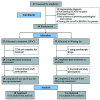The efficacy of transdiagnostic cognitive behavioural therapy on reducing negative affect, anxiety sensitivity and improving perceived control in children with emotional disorders - a randomized controlled trial
- PMID: 35532025
- PMCID: PMC9153761
- DOI: 10.4081/ripppo.2022.588
The efficacy of transdiagnostic cognitive behavioural therapy on reducing negative affect, anxiety sensitivity and improving perceived control in children with emotional disorders - a randomized controlled trial
Abstract
In response to the high rate of comorbidity among different types of emotional disorders in children, Transdiagnostic Unified Protocol of Emotional disorder in children (UP-C) was developed to address common underlying mechanisms in the development and maintenance of emotional disorders using empirically supported cognitive and behavioural strategies. Although, studies supported the effectiveness of this protocol in the treatment of wide range of emotional disorders, further studies are needed to examine its effect on transdiagnostic factors. The present study aimed to investigate the efficacy of the UP-C on negative affect, anxiety sensitivity and perceived control in children with emotional disorders. During this randomized controlled trial, 34 children aged 7 to 13 with emotional disorders were randomly assigned to treatment (n=18) and control (n=16) groups. The treatment group and their parents received 15 sessions of UP-C. Negative Affect Schedule for Children (PANASNA- C), Children's Anxiety Sensitivity Index (CASI), Anxiety Control Questionnaire-Children (ACQ-C) were carried out in all phases (pre-treatment, post-treatment, 3 and 8 months follow- up). The results showed that following UP-C, negative affect (hedges'g=2.01) and anxiety sensitivity (hedges'g=1.05) were significantly reduced, and perceived control (hedges'g= -2.36) was significantly improved. The results remained relatively constant during the follow-ups. Findings provide evidence that the UP-C has significant effect on negative affect, anxiety sensitivity and perceived control as roots of emotional disorders.
Conflict of interest statement
Conflict of interest: the authors declare no potential conflict of interest. Clinical trials: the study is registered in Iranian Registry of Clinical Trials (registration number: IR.ZUMS.REC.1398.216).
Figures
Similar articles
-
A Comparative Study on the Effectiveness of Unified Protocols for Transdiagnostic Treatment of Emotional Disorders and Modular Cognitive-Behavioral Therapy on Positive and Negative Affect, and Emotional Awareness in Children with Type 1 Diabetes Mellitus.Adv Biomed Res. 2025 Jan 30;14:4. doi: 10.4103/abr.abr_239_24. eCollection 2025. Adv Biomed Res. 2025. PMID: 40213593 Free PMC article.
-
The Spanish Version of the Unified Protocol for Transdiagnostic Treatment of Emotional Disorders in Adolescents (UP-A) Adapted as a School-Based Anxiety and Depression Prevention Program: Study Protocol for a Cluster Randomized Controlled Trial.JMIR Res Protoc. 2017 Aug 21;6(8):e149. doi: 10.2196/resprot.7934. JMIR Res Protoc. 2017. PMID: 28827212 Free PMC article.
-
Effectiveness of unified protocol for trans diagnostic treatment in children with anxiety disorders: A randomized control trial.J Educ Health Promot. 2023 Nov 27;12:387. doi: 10.4103/jehp.jehp_1578_22. eCollection 2023. J Educ Health Promot. 2023. PMID: 38333174 Free PMC article.
-
Towards an evidence-based unified psychodynamic protocol for emotional disorders.J Affect Disord. 2018 May;232:400-416. doi: 10.1016/j.jad.2017.11.036. Epub 2017 Nov 11. J Affect Disord. 2018. PMID: 29522960 Review.
-
A unified protocol for the transdiagnostic psychodynamic treatment of anxiety disorders: an evidence-based approach.Psychotherapy (Chic). 2014 Jun;51(2):224-45. doi: 10.1037/a0033815. Epub 2013 Dec 30. Psychotherapy (Chic). 2014. PMID: 24377407 Review.
Cited by
-
A Comparative Study on the Effectiveness of Unified Protocols for Transdiagnostic Treatment of Emotional Disorders and Modular Cognitive-Behavioral Therapy on Positive and Negative Affect, and Emotional Awareness in Children with Type 1 Diabetes Mellitus.Adv Biomed Res. 2025 Jan 30;14:4. doi: 10.4103/abr.abr_239_24. eCollection 2025. Adv Biomed Res. 2025. PMID: 40213593 Free PMC article.
-
Determinants of hemoglobin level and time to default from Highly Active Antiretroviral Therapy (HAART) for adult clients living with HIV under treatment; a retrospective cohort study design.Sci Rep. 2024 Jun 28;14(1):14929. doi: 10.1038/s41598-024-62952-w. Sci Rep. 2024. PMID: 38942753 Free PMC article.
-
Special issue: <em>Research in child and adolescent psychotherapy</em>Res Psychother. 2022 May 9;25(1):633. doi: 10.4081/ripppo.2022.633. Res Psychother. 2022. PMID: 35532022 Free PMC article.
-
A Systematic Review Comparing Four Transdiagnostic Programmes for School-Age Children.Clin Psychol Psychother. 2025 May-Jun;32(3):e70072. doi: 10.1002/cpp.70072. Clin Psychol Psychother. 2025. PMID: 40329505 Free PMC article.
-
Group dynamic-relational therapy for perfectionism.Res Psychother. 2022 Sep 1;25(3):635. doi: 10.4081/ripppo.2022.635. Res Psychother. 2022. PMID: 36052882 Free PMC article.
References
-
- Abramson L. Y., Seligman M. E., Teasdale J. D. (1978). Learned helplessness in humans: Critique and reformulation. Journal of Abnormal Psychology, 87(1), 49. - PubMed
-
- Allan N. P., Felton J. W., Lejuez C. W., MacPherson L., Schmidt N. B. (2016). Longitudinal investigation of anxiety sensitivity growth trajectories and relations with anxiety and depression symptoms in adolescence. Development and Psychopathology, 28(2), 459-469. - PubMed
-
- Allen L. B., Ehrenreich J. T., Barlow D. H. (2005). A Unified Treatment for Emotional Disorders: Applications With Adults and Adolescents (Invited Article). Japanese Journal of Behavior Therapy, 31(1), 3-30.
-
- Andrews G. (1996). Comorbidity and the general neurotic syndrome. The British Journal of Psychiatry, 168(S30), 76-84. - PubMed
LinkOut - more resources
Full Text Sources



